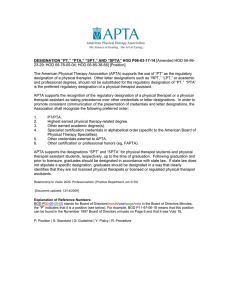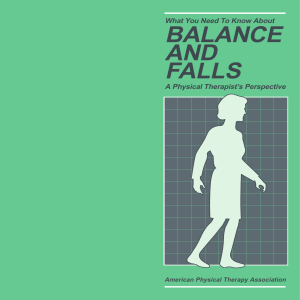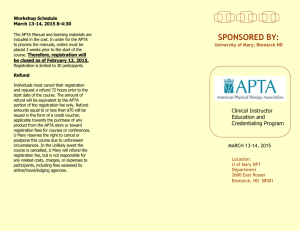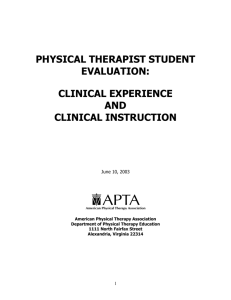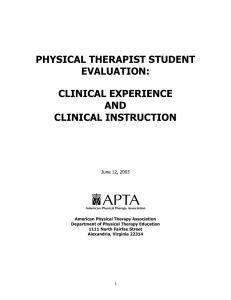The Physical Therapy Profession and APTA
advertisement
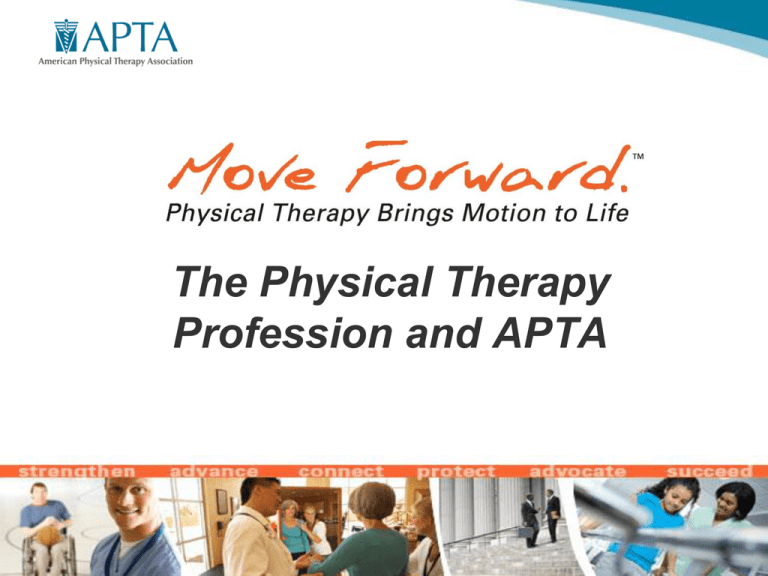
The Physical Therapy Profession and APTA Who We Are Our Beginnings Our Beginnings (cont.) • WWII • Polio epidemic APTA Today • • • • • • 77,000+ members Alexandria, VA 180 staff Vision 2020 R. Scott Ward, PT, PhD John D. Barnes, CEO Physical Therapists Improve Movement, Function, and Health • • • • • • • • • • Orthopedic conditions Joint and soft-tissue injuries Sports injuries Neurologic conditions Arthritic conditions Systemic conditions Cardiovascular and pulmonary conditions Workplace injuries Integumentary conditions Pediatric conditions Physical Therapist Education • Graduate with a post-baccalaureate degree from an accredited program; most offer a doctorate (DPT) • Must pass a state-administered national licensure exam; Physical Therapist Education (cont.) • 200 academic institutions • 213 accredited programs • 206 offer the professional DPT Physical Therapist Treatment • Therapeutic exercise • Functional training in self-care • Functional training in community and work • Manual therapy techniques • Devices and equipment Choosing a Physical Therapist • • • • • • Find-A-PT Direct access to PT www.apta.org/advocacy Choice is yours Licensed PT Covered by insurance Your First Visit to a PT • Evaluation • Examination • Plan of care Payment for Physical Therapist Services Medicare • • Medicaid • Private insurance companies • Federal employee health benefit program • Workers’ compensation programs • Self-pay • HMOs, PPOs • Automobile liability programs PT Specialist Certification • • • • • • • • Cardiovascular and pulmonary Clinical electrophysiology Geriatric Neurologic Orthopaedic Pediatric Sports Women’s health Practice Based on Evidence • • • • • Shortens stays in the ICU Reduces risk of postnatal depression Improves function after back surgery Improves movement in premature infants Improves postural stability in patients with Parkinson disease Evidence (cont.) • Effective for pregnancy-related incontinence • Effective for relieving pain and stiffness associated with OA of the knee • Successfully treats lymphedema Dynamic Areas of PT Practice • Diabetes • Emergency/Urgent care • Hospice Care • Obesity Management • Performing Arts • Women’s Health The Physical Therapist Assistant • Under direction and supervision of a licensed PT • 2-year associate’s degree • Teaching exercise, training in activities of daily living, using physical agents Where PT Members Practice PT Age Distribution 16 14 12 10 8 6 4 2 0 Age Distribution 20-24 - 0.9% 25-29 - 12.9% 30-34 - 14.5% 35-39 - 14.3% 40-44 - 13.6% 45-49 - 13.5% 50-54 - 12.9% 55-59 - 10.8% 60-64 - 4.4% 65+ - 2.2% PT Employment Status A “Top” Profession Top 100 rank: 4 Sector: Health Care APTA’s Strategic Plan • • • • • • Access to PT Services Education Payment for Services Public Awareness/Recognition Research Practice Standards A Few Current APTA Initiatives • • • • Health Care Reform Physical Therapist Brand Direct Access Elimination of Therapy Caps



